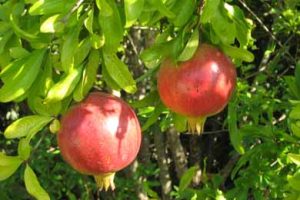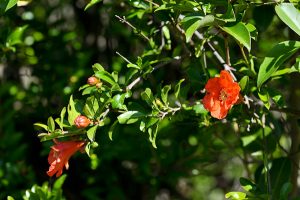



Pomegranate in Tunisia
The culture of pomegranate is very old in Tunisia. It dates, at least, of the time phenician.
The pomegranate is cultivated in the coastal areas of north, the center and the south and in much of areas inside the country. This species is regarded as a principal component of the oases of the south. However, one notes a domination of Beja and Nabeul in North, like Sidi Bouzid, Kairouan and Mehdia for the Center, and Gabès in the South. However, the latter monopolizes most of the orchard.
This area is known since the olden days by its merry coastal oasis. This oasis is classified like most important of the Mediterranean dimension.
Of this mixture of the Mediterranean, of one ground at the same time rich in salt and generous and of a sky shone upon throughout the year is produced the variety of grenade known as “Gabsi Grenade”.
Description
It is a large round bay, size of a large orange, with hard bark and coriace, of red color or yellow-beige, which contains in “cabins” delimited by thick partitions, many pips of color pink-salmon to red ruby, of the gem shape characteristic of ruby.
In each pip, the seed is coated with a gelatinous pulp of transparent red flesh, sweetened at the improved varieties, if not of a rather bitter taste. Only the pips constitute the edible part of the grenade is approximately half of the fruit.
With maturity, the skin of the grenade darkens, is thinned and hardened to the extreme. Its bark then constituting an effective protection for the pulp locked up inside very many thin partitions.
A fruit, a soil
The area of Gabès in the south is very known for these pomegranates which develop with the shade of the palm trees – date palms of its peaceful coastal oases. As of the Middle Ages, Arab chroniclers and geographers mentioned the exceptional quality of the grenades of Gabès. Though largely spread and cultivated in the coastal areas of north, the center and the south and in much of areas inside the country, the pomegranate remains closely related in the spirit of very famous Tunisian with Gabès to the national level for its grenades of excellent quality whose project of valorization and protection by a recording in one of the identification marks of the origin and quality is under study.
Tasting
With the purchase, select the grenades whose bark is dark, of a major red to brown. The small grenades are usually dry, woody, bitter and inedible. The heavier the fruit is, the more pulp will be juicy. The skin must be quite smooth and brilliance, free from brunissures. It is said that the fruit is ripe when while typing above, it emits a metal sound.
The fruit is eaten natural to peel grain by grain and he is very appreciated children. He can be used to make sorbets, drinks, artisanal syrup of grenadine, which enters like ingredient cooked dishes.
In addition to consumption in a fresh state, the fruits are used for the manufacture of soft drinks. By-products (bark of the fruits, etc) are used, traditionally, in popular medicine and dyeing.